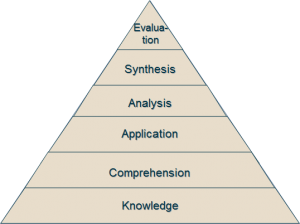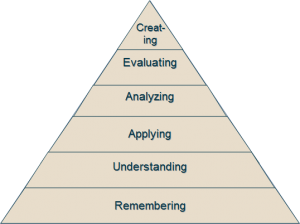One of the chief tenets of good instructional design is to begin with the end in mind, as in: what do your learners need to be able to do by the end of your training? How will you measure their success?
These considerations, of course, are what go into the objectives that we set out at the beginning of our training to define its purpose and outcomes. However, beginning with the end in mind can be easier said than done, especially when you’re dealing with complex curricula or multiple learning paths. Writing objectives forces you to consider your audience, user roles, knowledge gaps, resources, and so forth, but how do you actually get to that point in your course design? How do you parlay these considerations into a “big-picture” endgame while keeping your eye on building effective training step-by-step?
Bloom’s Taxonomy: A Classification of Learning Behaviors
Benjamin Bloom’s Taxonomy of Educational Objectives, published in 1956, sought to address that very conundrum. Bloom’s goal was to help classroom educators establish a terminology around learning behaviors to help them assess their students’ comprehension. In doing so, he and his team fashioned a hierarchy of educational goals, shaped like a pyramid with the most foundational, lower-order thinking skills at the bottom and higher-order skills at the top:

In 2001, the original Taxonomy was revised by a former student and colleague of Bloom’s to reflect new research and insights into the way people learn. The most obvious revision was to Bloom’s terminology, switching the original terms from nouns to verbs and shifting the focus from learning behaviors to learning processes:

Because the levels of learning are arranged in a hierarchy from least to most complex, the structure of the Taxonomy is also cumulative, meaning that a learner can’t be expected to obtain proficiency at the higher levels without first gaining a solid grounding in the lower ones. This makes perfect sense: for example, you wouldn’t be able to analyze or evaluate information without first gaining a basic understanding of what it means.
So how does this help you define the objectives for your eLearning courses? Let’s take a look at Bloom’s in action.
Putting Bloom’s to Work
Bloom’s Revised Taxonomy is a powerful tool to have in your eLearning arsenal, thanks to its utility in helping you choose appropriate delivery methods for your desired learning outcomes. To ensure that these outcomes are met, you can develop assessments, activities, or other forms of evaluation based on the same objectives. The process of writing effective learning objectives essentially breaks down into just three steps.
Step One: Find Your Level
First, identify where the goals for your training fall on the taxonomic hierarchy. At the end of your lesson or course, do your students need to have a fairly basic understanding of the information you’ve given them, or will they need to deploy more complex thinking skills to demonstrate their grasp of the material? Here’s a tip: aim high! If you’re developing training that requires learners to accrue higher and higher levels of comprehension, make sure you don’t shortchange them by setting your learning goals too low or they won’t be able to advance from one level to the next.
Step Two: Choose Your Verbs
The levels in the Taxonomy are associated with a number of action verbs that can be useful in helping you define your learning objectives; use them to get thinking about which verbs correlate your learning goals with the content and assessment that you’ll develop to make sure those goals are met.
Drag and drop the levels into place below to see some examples of their accompanying action verbs:
These verbs will not only give you an active vocabulary for the actions you expect your learners to take at the end of training, but also, crucially, to construct learning objectives at the level at which you expect those learners to perform.
Step Three: Determine Your Outcomes
Now that you know what level of learning you expect your learners to achieve and the terms you will use to define it, bring these elements together with an outcome that will allow learners to demonstrate their mastery of the subject at hand. It’s important when writing objectives to establish outcomes that are measurable and observable, as well as in line with the corresponding level of learning. For example, an assessment at the lowest level, remembering, might involve a learner being able to recite a list from memory. You can have a learner perform a simulation to prove that they can apply their knowledge to a more complex task. Analyzing, evaluating, and creating will all require more advanced activities or assessments, such as choosing the best answer from a scenario or compiling information together in a new or alternative way.
Now what?
The medium of eLearning offers myriad opportunities to leverage Bloom’s Taxonomy in establishing learning objectives; use this job aid I put together for more ideas.
There are innumerable resources available online and in print about Bloom’s Taxonomy and its use in eLearning development. For starters, you can check out my prior post on the subject.